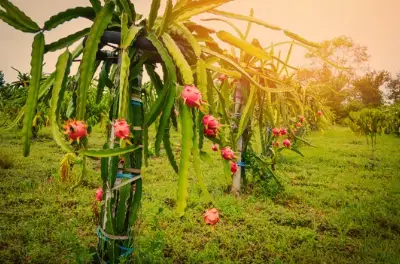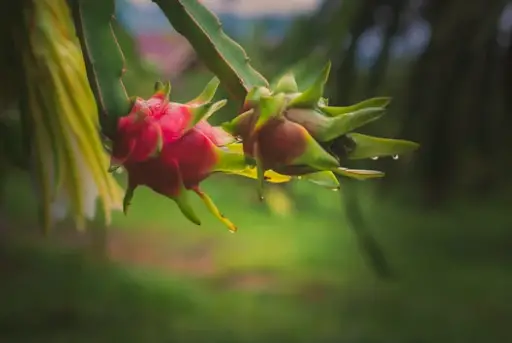Dragon fruit plants are renowned for their striking appearance and delicious, exotic fruits.
As a gardener, it can be disheartening to see your dragon fruit plant turning yellow, leaving you puzzled and concerned about its health.
In this blog post, we will delve into the possible causes behind the yellowing of dragon fruit plants and provide you with effective solutions to restore their vitality and beauty.
What is the Dragon Fruit Plant?

What is the Dragon Fruit Plant
Before we dive into the causes of yellowing, let’s take a moment to familiarize ourselves with the dragon fruit plant.
Native to Central America and commonly found in tropical regions, dragon fruit plants belong to the cactus family.
They are epiphytic climbers that produce vibrant flowers and, eventually, the coveted dragon fruits.
To ensure successful cultivation, it is crucial to understand the plant’s natural requirements.
Why Is My Dragon Fruit Plant Turning Yellow?

If you’ve noticed your dragon fruit plant turning yellow, it’s natural to be concerned about its health.
Yellowing foliage in a dragon fruit plant can be indicative of various underlying issues. Let’s explore some of the common causes of yellowing in dragon fruit plants:
Assessing the overall health of the plant and considering environmental factors will help in identifying and addressing the specific issue.
Remember, prevention is key. Maintain a proper care routine for your dragon fruit plant, including providing adequate sunlight, proper watering, regular fertilization, and prompt intervention in case of pests or diseases.
So, by addressing the underlying causes and providing optimal care, you can restore the health and vibrancy of your yellowing dragon fruit plant.
Common Causes of Yellowing Dragon Fruit Plants

Lack of Adequate Sunlight:
Dragon fruit plants thrive in bright sunlight, requiring at least 6-8 hours of direct sunlight daily.
Insufficient sunlight exposure can lead to yellowing of the plant’s foliage. If your dragon fruit plant is not receiving enough sunlight, it may struggle to produce energy through photosynthesis, resulting in reduced growth and yellowing leaves.
Solution
Position your dragon fruit plant in a location where it can receive ample sunlight. Ideally, place it in a spot with full sun exposure throughout the day. If you are growing dragon fruit indoors, consider using grow lights to supplement the light requirements.
Improper Watering Practices:
Overwatering or underwatering can have detrimental effects on dragon fruit plants, causing the leaves and stems to turn yellow. These practices disrupt the plant’s ability to absorb nutrients properly and can lead to root rot or dehydration.
Solution
Ensure that the soil is well-draining to prevent waterlogging. Water your dragon fruit plant thoroughly, allowing the soil to dry out between waterings. Stick your finger into the soil to check the moisture level before watering again. Adjust the watering frequency based on the environmental conditions and the plant’s needs.
Nutritional Deficiencies:
Yellowing leaves may be a sign of nutrient deficiencies in dragon fruit plants. Common deficiencies include nitrogen, iron, or magnesium deficiencies. These nutrients are vital for maintaining healthy foliage and overall plant growth.
Solution
Conduct a soil test to identify any nutrient deficiencies. If deficiencies are detected, you can address them by providing appropriate supplements or fertilizers. Select a balanced fertilizer specifically formulated for cacti and succulents or use organic options. Follow the instructions provided on the product packaging to ensure proper application and dosage.
Pests and Diseases:
Pests and diseases can also contribute to the yellowing of dragon fruit plants. Common culprits include spider mites, mealybugs, bacterial or fungal infections, and root rot. These issues can weaken the plant and disrupt its normal physiological functions.
Solution: Regularly inspect your dragon fruit plant for signs of pests or diseases. If you detect any issues, take immediate action to control the infestation or treat the disease. Depending on the problem, options include using organic pest control methods, applying appropriate fungicides, or removing and replacing severely infected plants.
Troubleshooting and Remedies
- Assessing Plant Health: When troubleshooting the yellowing of your dragon fruit plant, take a closer look at its overall health. Examine the leaves, stems, and roots for any visible signs of stress, damage, or infection. Additionally, consider factors such as recent changes in environmental conditions, watering practices, or fertilizer application.
- Implementing Corrective Measures: Once you have identified the cause(s) of yellowing in your dragon fruit plant, take appropriate actions to rectify the situation. Here are some specific remedies based on the common causes mentioned earlier:
- Lack of Adequate Sunlight: Reposition the plant to a sunnier location or provide supplemental grow lights to ensure sufficient light exposure.
- Improper Watering Practices: Adjust the watering frequency and ensure the soil is well-draining. Be cautious not to overwater or underwater the plant.
- Nutritional Deficiencies: Based on soil test results, apply suitable fertilizers or nutrient supplements to address any deficiencies. Follow the instructions provided by the manufacturer.
- Pests and Diseases: Employ appropriate pest control measures, such as manually removing pests or using organic pest control methods. Treat diseases with recommended fungicides or other appropriate treatments.
Prevention and Maintenance Tips
Regular Monitoring:
Keep a close eye on your dragon fruit plant for any changes in growth, leaf color, or signs of pests or diseases. Early detection allows for prompt intervention and prevents further damage.
Proper Care Practices:
Maintain proper care practices to ensure the long-term health of your dragon fruit plant. This includes providing adequate sunlight, using well-draining soil, watering appropriately, and applying fertilizers as needed. Follow a regular maintenance routine, which may include pruning, removing dead or damaged parts, and maintaining a clean growing environment.
Soil Quality:
Ensure that the soil is rich in organic matter and well-draining. This promotes healthy root development, nutrient uptake, and overall plant vigor. Periodically check the pH level of the soil to ensure it is within the optimal range for dragon fruit plants (around 6.0-7.0).
Conclusion
The yellowing of a dragon fruit plant can be worrisome, but with a thorough understanding of the causes and appropriate remedies, you can restore its health and beauty.
So With adequate sunlight, proper watering, addressing nutrient deficiencies, and promptly addressing pests or diseases, you can revive your yellowing dragon fruit plant.
Remember to maintain regular monitoring and follow good care practices to ensure the long-term vitality of your plant.
With patience and diligent care, your dragon fruit plant will flourish, rewarding you with abundant and vibrant fruits.
Reference
To obtain accurate and detailed information about the causes of yellowing in dragon fruit plants, I recommend referring to reputable gardening websites, and horticultural books, or consulting with local agricultural extension offices or experts. These sources can provide specific scientific studies, practical experience, and in-depth information on the topic.
Here are a few reliable sources related to dragon fruit cultivation and care that you can explore for further reference:
- University of California Cooperative Extension: “Dragon Fruit Production in California”
- University of Florida IFAS Extension: “Dragon Fruit Production Guide for Florida”
- Available at: http://edis.ifas.ufl.edu/hs1226
- International Society for Horticultural Science (ISHS): “Pitahaya: A New Crop for Australia”
- Available at: https://www.ishs.org/ishs-article/825_8
- Gardening Australia: “How to Grow Dragon Fruit”




